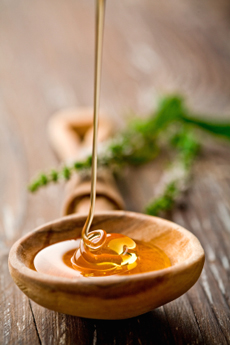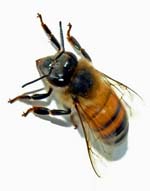

Honey, man’s first sweetener, was affordable to the average European when sugar was a luxury for the rich. Photo by Liv Friis-Larsen | IST.
September 2007
Last Updated June 2013
|
 |
The History of Honey
40 Million Years Of Honey & Honey Bees
CAPSULE REPORT: Only relatively recently in man’s history—since the mid-19th century—did sugar become affordable to the average Westerner. Prior to then, it was a very expensive luxury (as were chocolate and tea), imported from long distances and enjoyed by the wealth. Honeybees, native to Asia, were brought to the New World by colonists in 1622. There are about 300 different varieties of honey in the U.S. alone, reflecting the variety of plant blossom from which the bees draw their nectar.
History of Honey
Honey was man’s first and most reliable source of sweetener. The oldest written reference to honey dates back to the Egyptians in 5500 B.C.E., and references to honey abound in antiquity. But honeybees are far older than man’s historical record, written or otherwise. Homo sapiens evolved 50,000 years ago; bees were making honey perhaps 40 million years before that.
Honeybees as a group appear to have their center of origin in Southeast Asia. At about 30 million years ago they appear to have developed social behavior and structurally are virtually identical with modern honeybees. Apis mellifera, known as the Western honeybee, is the most commonly domesticated species. It probably originated in Tropical Africa and spread from there to Northern Europe and East into Asia.
Native Americans did not know honey. In 1622, the first European colonists brought the sub-species Apis mellifera mellifera to the Americas. Many of the crops that depend on honeybees for pollination have also been imported since colonial times. Escaped swarms (wild bees) spread rapidly as far as the Great Plains, usually preceding the colonists. Honeybees did not cross the Rocky Mountains; they were carried by ship to California in the early 1850s. Today, bees are ubiquitous: Honey is produced in every state of the U.S., and in most countries on earth. California, North Dakota, Florida, South Dakota, Montana and Minnesota account for 63% of U.S. production.
Until cane sugar, which originated in southeast Asia, became commercially available and affordable in the mid-19th century, honey was the major sweetening agent for Westerners. It sweetened tea, cakes and candies.
Types of Honey
Unlike cane sugar, which tastes the same wherever it is grown, the color and flavor of honey is very specific to the nectar of the flower from which it is drawn, and the region where the flower grows. Eucalyptus honey from California, for example, can taste and look different from Australian eucalyptus honey.
|

Honey Bee. Photo by V.T. Upinamba | CSP. |
There are 300 or so different varietals of honey in the U.S. alone, generally named for the plant (tree, shrub or flower) from which they originate. Some of America’s most widely-available honeys are clover, orange blossom and sage. More rare, regional honeys include buckwheat, heather, raspberry, spearmint and thyme. Greece is famous for wild thyme honey, France for lavender and acacia honey. In Australia, the most common honey comes from the different species of eucalyptus trees. Tasmanian leatherwood honey is considered a delicacy among honey connoisseurs for its unique, complex and robust flavor.
Honey should be seen as a condiment like mustard: You can vary your choice of honey based on how you want to flavor your dish.
- Blueberry honey, from Maine and other parts of the Northeast and Michigan, is amber-hued, rich and dense with a moderate fruity flavor and a delicate blueberry aftertaste.
- White sage honey, from the sage shrubs of California, is translucent yellow in color with a clover-like flavor and an elegant floral aftertaste.
- Saw palmetto honey, from Florida’s saw palmetto tree, is medium-amber in color and full-bodied in flavor with citrusy, herbal and woody overtones.
- Buckwheat honey, from upstate New York, is dark brown in color with a strong, malty, buckwheat flavor.
See an extensive list of varietal honeys (also called monofloral honeys) and how to pair them with food.
What To Know Before You Buy
Much of the honey produced in the U.S. are the pale, delicately-flavored alfalfa and clover honeys; mild clover honey comprises about 45% of the market. A lot of supermarket-quality honey is imported in bulk from Argentina, China and Canada. Mass-marketed honeys are often filtered, heated (pasteurized) and blended to create a uniform, generic flavor profile—sweet and bland, without varietal character. In order to provide it to the large bottlers for the cheapest cost, the beekeepers make as much honey as possible, no matter what the nectar source. It’s sweet but bland—there’s no complexity of flavor. Bake with it, but for topping off toast or pound cake, or even glazing meat, you deserve something better.
If a honey label denotes a varietal flower source—orange blossom, for example—then that is the predominant nectar from which the honey is derived. It does not mean that the honey is 100% orange blossom honey, only that the floral source is the most dominant. While the hives may have been set in a grove of orange trees, the beekeeper cannot control where else the bees may have flown to draw nectar; or the honey may have been blended with other honeys for a number of reasons.
|





